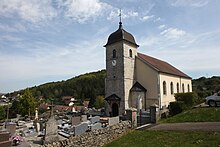Tarcenay
| Tarcenay | ||
|---|---|---|
|
|
||
| local community | Tarcenay Foucherans | |
| region | Bourgogne-Franche-Comté | |
| Department | Doubs | |
| Arrondissement | Besançon | |
| Coordinates | 47 ° 9 ' N , 6 ° 7' E | |
| Post Code | 25620 | |
| Former INSEE code | 25558 | |
| Incorporation | 1st January 2019 | |
Tarcenay is a village and a former commune with last 1,015 inhabitants (2016) in the Doubs department in the region of Bourgogne Franche-Comté . It belonged to the arrondissement of Besançon and the canton of Ornans .
With effect from January 1, 2019, the formerly independent municipalities of Tarcenay and Foucherans were merged to form the Commune nouvelle Tarcenay-Foucherans , although they were not granted the status of a Commune déléguée in the new municipality . The administrative headquarters are in Tarcenay.
geography
Tarcenay is located at 479 m above sea level, about eleven kilometers southeast of the city of Besançon (as the crow flies). The village extends in the Jura , slightly elevated on the southern edge of the first plateau between the Jura ridge in the north and the Rocher de Punay in the south.
The area comprises a section of the stratified landscape of the western French Jura. The main part is taken up by the Tarcenay plateau, which is on average 460 m. It consists partly of arable land and meadow, partly of forest. The Charmont ( 500 m ) in the middle of the plateau is a witness mountain . Apart from a few short rivulets, the entire plateau has no surface watercourses because the rainwater seeps into the karstified subsoil. The landscape is characterized by various karst phenomena such as sinkholes , covered cart fields , caves and shafts. A terrain step about 80 meters high leads to the south and east to the next higher layer step . Here, at 565 m, the highest point in Tarcenay is reached. The southern boundary lies above the steep drop to the Ravin du Puits Noir , a right side valley of the Loue . To the north, the area extends over the plateau to the edge of the Marais de Saône marshland .
In addition to the actual village, Tarcenay also includes various hamlets and individual farms, including:
- Les Cloutiers ( 457 m ) on the plateau on the edge of the Bois l'Essart
- La Baraque des Violons ( 445 m ) on the plateau west of Gros Mont
- Les Rubis ( 462 m ) on the plateau on the edge of the Bois l'Essart
- Bois-vielle ( 460 m ) on a hill on the northern edge of the plateau
Neighboring towns of Tarcenay are La Vèze and Saône in the north, Le Gratteris and Foucherans in the east, Scey-Maisières in the south and Malbrans , Villers-sous-Montrond and Mérey-sous-Montrond in the west.
history
The first written mention of Tarcenay was under the name Terceniacus . The church was probably founded in 896 by Archbishop Bérenger of Besançon. In the Middle Ages, Tarcenay formed its own rule, which was under the sovereignty of the cathedral chapter of Besançon. Together with Franche-Comté , the village came to France with the Peace of Nijmegen in 1678. Most recently, Tarcenay was a member of the Communauté de communes du Pays d'Ornans .
Attractions
The current village church of Saint-Martin in Tarcenay was built in the 19th century. Only a few traces of the former Château de La Tour are visible. In the center there are numerous farmhouses in the characteristic style of Franche-Comté from the 17th to 19th centuries. On the summit of Charmont there is a statue of the Blessed Virgin.
population
| Population development | |
|---|---|
| year | Residents |
| 1962 | 342 |
| 1968 | 316 |
| 1975 | 363 |
| 1982 | 462 |
| 1990 | 588 |
| 1999 | 628 |
| 2006 | 828 |
| 2016 | 1015 |
After the population had decreased significantly in the first half of the 20th century (482 people were still counted in 1886), a marked increase in population has been recorded again since the beginning of the 1970s.
Economy and Infrastructure
Until well into the 20th century, Tarcenay was a village characterized by agriculture (arable farming, fruit growing and cattle breeding) and forestry. In addition, there are now some local small businesses. In the meantime, the village has also turned into a residential community. Many workers are commuters who work in the larger towns in the area.
The village is well developed in terms of traffic. It is on the main D67 road from Besançon to Ornans . Further road connections exist with Mérey-sous-Montrond, Villers-sous-Montrond and Trépot.
literature
- Le Patrimoine des Communes du Doubs. Volume 2, Flohic Editions, Paris 2001, ISBN 2-84234-087-6 , p. 859.

